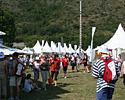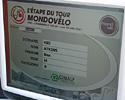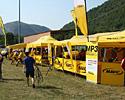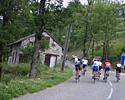
Recently on Cyclingnews.com |
L'Etape du Tour 2007, July 31, 2007
Pyrenean Inferno

|
L'Etape du Tour (literally, 'the Stage of the Tour') is now in its 15th year. From a humble 1705 - mostly French - participants in 1993, the event has grown steadily to its current level where the maximum allowable 8,500 entries sell out quicker than cup final tickets. The list of participants is still dominated by the host nation, but the proportion of foreigners has been rising steadily and riders from outside France this year number 2930, making up over a third of the field - the UK fielding 1319 (more than 15%). One of those happy few was Cyclingnews' UK Editor, and all round Fall Guy, Ben Atkins.
L'Etape has always been at the forefront of the surge in popularity of Cyclesportifs, which combine the endurance of cycle tourism with the glamour of racing. Basically, they give all us wannabes with our expensive bikes a chance to swan around pretending to be pros for the day (even if our performance doesn't always deserve it!). There are tougher events, there are some that are more fun, but none quite match the kudos of being an actual stage of the Tour de France.
Unlike most cyclesportifs, l'Etape takes on a different route every year, as it covers the exact course of a selected stage. Generally speaking it alternates between the Alps and the Pyrenees, but has also included stages in the Massif Centrale, and in 2000 tackled the stage to Mont Ventoux. The organisers - who are part of the Tour's umbrella organisation, ASO - generally pick a course that will provide a real challenge for all participants. To this end, this year's l'Etape took on the parcours of Stage 15, one of the queen stages of the Tour, the almost 200km between Foix and Loudenvielle-Le Louron.
The course includes five serious climbs: the Col de Port (1,249m), the Col de Portet d'Aspet (1,069m), the Col de Menté (1,349m), the Port de Balès (1,755m) and the Col de Peyresourde (1,569m). Of these, only the Port de Balès should cause serious problems in isolation, but the cumulative effect of all five, plus the toll that 200km will take on the legs make this stage a really tough undertaking.

|
Despite my numerous Gran Fondos and 'classics' I've only done l'Etape once before: the 2003 event from Pau to Bayonne, on the route of the stage won by Tyler Hamilton a week or so later. I'd narrowly missed out on a Silver medal that year (Silver and Gold medals are awarded based on your performance based on times set for your age category), but after my less than Rasmussen-esque climbing performance in the Gran Fondo Dolomiti Stars a few weeks ago, I was under no illusions of bettering that this time around. Once again, I'm here to avoid the - seemingly generous - broom wagon cut-off time of 12 hours. This year for me, and for many others, the objective is to see the finish line while still on two wheels.
With me on the trip was Lindsay Crawford, a multiple Etapiste. Lindsay is used to getting Gold medals for his performances, and actually won his age group in the 2003 edition - when I last rode.
As Lindsay was riding to win his age group again, he wanted to be at the front from the start. We were already in the front grid courtesy of our sub-500 bib numbers, but to get to the front of this grid we arrived at the start in the Ariegoise capital of Foix at around 4:30am, ready for a 7am start! I've been eligible for front grids before - in fact at Dolomiti Stars I was given number five - but I've never really had the bottle to go there. Not wanting to get in the way of the fast boys, or get crushed in the rush to start, I've always deliberately put myself much further back, but today I was rather looking forward to it.

|
As the start approached, the other several thousand riders steadily filled up their grids - according to their numbers - and as our small pen began to get really crowded, the real VIPs began to arrive, by climbing in over the barriers! I helped number seven with his bike and he shook my hand as if I was expected to know who he was (sadly even after looking him up in the results I'm still none the wiser, but I suppose he's quite big in France). With a few minutes to go though, the real guest of honour arrived: wearing number one - and living proof that you can be an American multiple Tour winner and still be popular in France - Greg LeMond was escorted by several interviewers, a mass of photographers, and a generous ovation, to the front row of the grid as the starter counted us down.
As the flag was dropped, I bade Lindsay farewell to the sound of seven thousand pedal cleats engaging (for some reason, over a thousand hadn't turned up), and we were off through the streets of Foix, at the beginning of what for many of us would prove to be a very long day. I glued myself to the right hand kerb, as those fast guys who started behind me would be sure to want to come past. Sure enough, as we negotiated the road furniture on the way out of town, several hundred hopefuls streamed by me on the way to the front.
Despite being passed by so many riders though I was still holding my own at this point, and surprising myself by matching the pace of the huge peloton as we swept out of town. Giant were one of the main sponsors this year, so there was a big presence of VIPs and journalists on TCRs with me, including many of my team mates from Giant Tours of the past. Soon though, the groups began to split as we hit a small climb, and I found myself in the middle of the third bunch of around three hundred, most of my old coequipeurs having disappeared up the road. This suited me though, and I settled in with the intention of doing as little as possible en route to the first climb of the day, the Col de Port.

|
At only 1249 metres high, the Col de Port is not the toughest climb in the world, and is only rated as a second category one by the Tour de France. The mid section is pretty tough though and after a few kilometres I got the familiar sensation of what felt like the entire rest of the field streaming past me on their way up. I kept an eye on everyone's bib numbers though, as this gives an indication of how far back in the field they started and I was pleased to see that it was only the first couple of pens that were catching me at this point. For the last few kilometres the road begins to level out and I could move up the gears a bit - even latching on to the occasional faster wheel as it went by.
I crested the top, zipped up my jersey and took to the descent, glad of a bit of freewheeling for a while. I needed to get down this pretty quickly so as not to get left behind by the decent groups that would doubtless form at the bottom - there was to be a long flat section before the next climb that I didn't want to get isolated on - but at the same time I didn't want to take any unnecessary risks on unfamiliar roads. Consequently I managed to pass a few on the way down, but quite a few went past me too.
Sure enough, at the bottom some groups started to form and I managed to tack myself onto the back of a pretty fast moving bunch of something like 200 riders. Not wanting to get stuck behind a split I decided to move up a bit, but this proved no mean task at the speed we were doing, My top gear of 50x13 isn't very big for this kind of riding, but I managed to make it forward a few places at a time whenever the pace slowed a bit - the rest of the time we were going so fast that pedalling in any meaningful way wasn't really possible!
At St Girons - after 70km - was the first official ravitaillment, or feed station. Much of the bunch decided that they didn't want to stop here, but I had at least one empty bidon, and it doesn't do any harm to grab a bit more food, even though I still had plenty in my pockets. To my delight they had boxes and boxes of pâtes des fruits - delicious fruit jellies made without gelatine, and therefore vegetarian! I grabbed a big mouthful (and I have a big mouth) of these, filled up my bottle and rejoined the course.

|
Unfortunately, I managed to rejoin just as a big group was going past and I couldn't quite get my speed up in time to join on the back. Luckily though there were a few others in the same boat and I managed to work with a Dutch rider over a few kilometres to get on to the back and the same pattern as before as we sped on our way towards the foot of the Col de Portet d'Aspet.
As the climb began we passed a sign proclaiming "100km to the finish". Cool, it had only taken me three hours and twenty minutes to do the first half, I wonder if I'll be able to do the second half as quickly… Somehow I doubt it, we may have done half the distance, but only one out of the five climbs - and it was the easy one!
The Portet d'Aspet starts fairly gently, but after a couple of kilometres it suddenly steepens quite sharply and stays that way right to the top. The sun was pretty high by now and the temperature and gradient were conspiring with each other to make things pretty hot for all of us. I unzipped my jersey all the way down and it flapped in whatever breeze I was generating (not much!) as I inched my way to the top.

|
Once at the top I zipped up my jersey and started downhill, but this was one descent that I was in no hurry on! With our numbers and timing chips we'd also been given a sheet of paper with the dangerous points of the course pointed out. For this descent it simply said "Remember Casartelli, be very careful". Advice taken and heeded! I had thought about stopping to take some pictures of the memorial to the 1992 Olympic champion, but with sections of 17% on the way down I was in no mood for doing anything any more ambitious than staying upright. Anyway, there are thousands of pictures of the memorial out there; there was no need for me to risk life and limb - of me or anyone else - to get one more! I did manage to doff my helmet to him though as I passed the plaque and flowers at the point where he actually crashed (would things have been different if he'd been wearing one himself?).
Pleased to have got to the bottom rubber side down, after passing a couple of people who weren't so lucky, I shot straight on to the start of the next climb, the Col de Menté. I have to confess to not knowing too much about this climb, it tends to come as a pair with the Portet d'Aspet, but is generally overshadowed in terms of publicity by the ignominious history of its neighbour. I soon knew all about it though.
The Col started anonymously enough, the gradient never really putting me in trouble, in fact after a few kilometres there was a bit of a descent as it crossed a valley, but as soon as it was on the other side it really started in earnest. The sun that had seemed pretty high on the previous climb was now shining at its maximum intensity and the south facing slopes of the climb were totally exposed to it. As well as this, the gradient had kicked up to somewhere the other side of steep. I wasn't expecting this, having been concentrating on how hard the next mountain would be; I'd hardly looked at this one.
To go to page two, click here.
